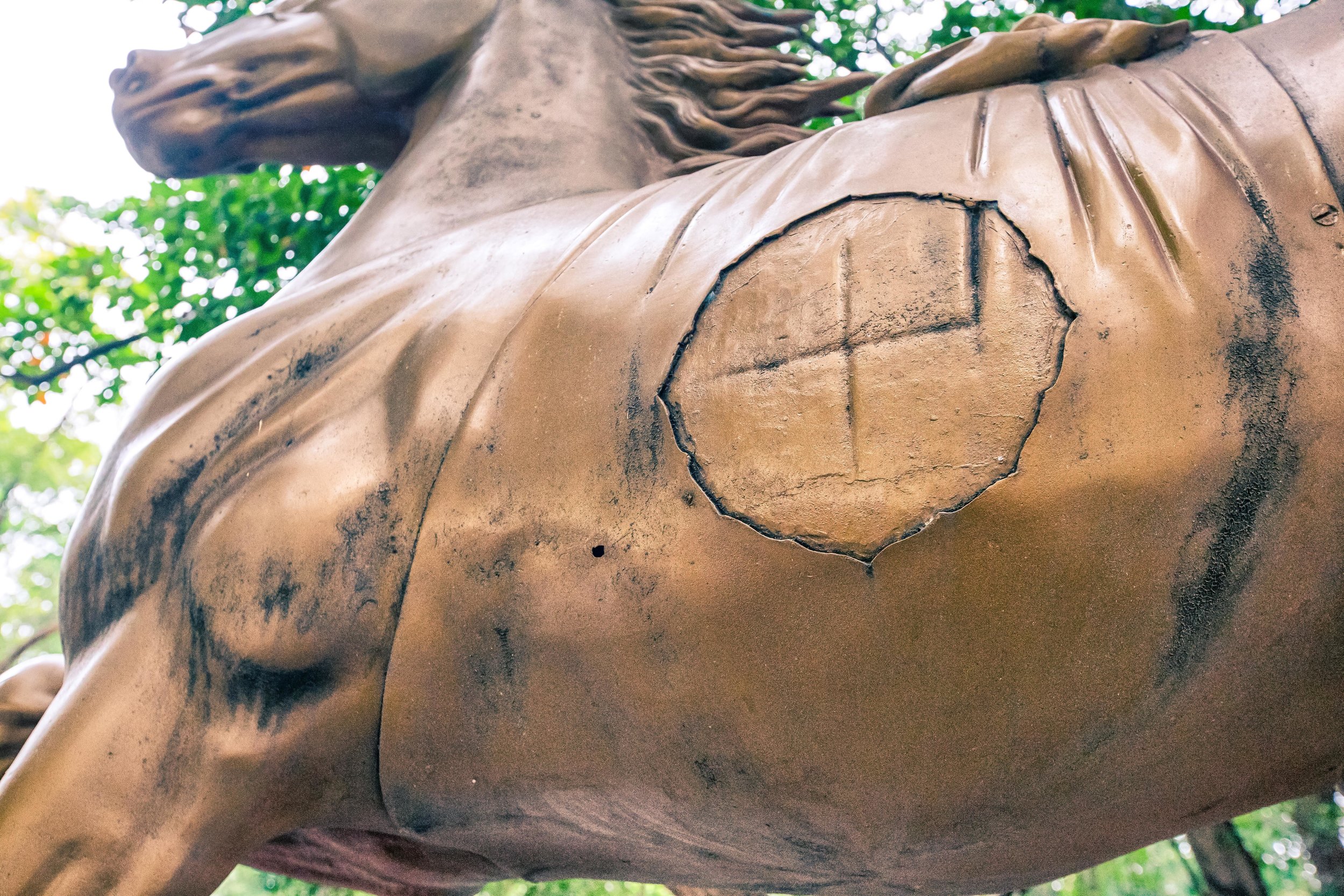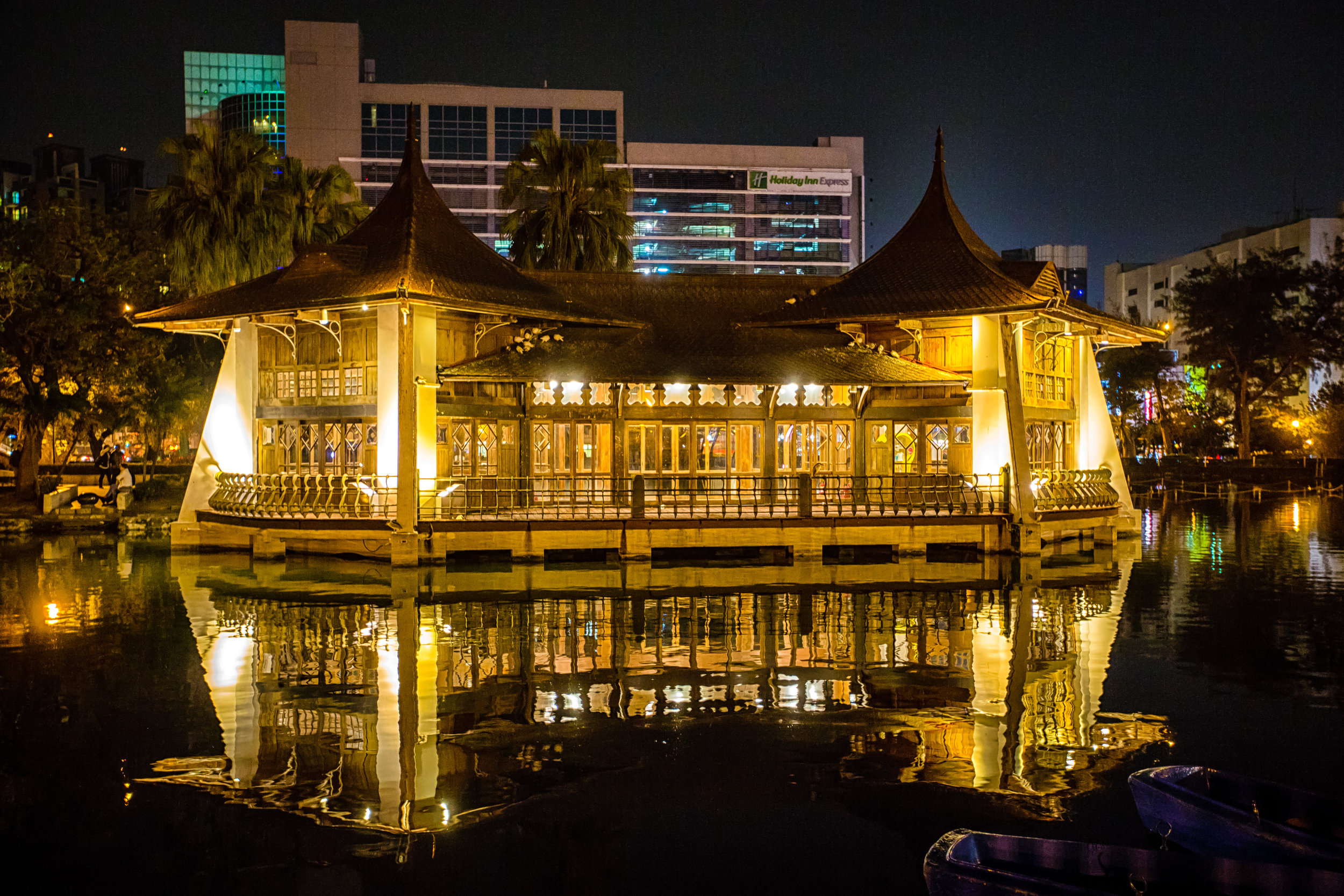Taichung Park (台中公園) is a 10 acre park situated within the downtown core of Taiwan's central Taichung city. The park is the oldest in the city with a century year history dating back to the early stages of the Japanese Colonial Era.
The expansive park is an important recreational area for the people of Taichung which features several important pieces of Taichung's history mixed in with the jungle gyms, basketball courts and a lake for kayaking and canoeing.
Originally known as Nakanoshima kōen (中之島公園) the park was constructed in 1908 and has been listed by the Taichung City Government as a protected historical site owing to the various historical monuments on site.
My first post about the park focused on its most famous landmark, the beautiful century-old Mid-Lake Pavilion (湖心亭). The park however has a few other historical landmarks which (for the most part) date back to the Qing Dynasty.
With this post, my purpose won't be to focus on history of each of the historical monuments found within the park (although I will provide a few photos of them) but instead focus more on something that really irritated me and something that has actually been bothering me for a while.
Let me start with a bit of a backstory - A few weeks ago an article surfaced from the Japan Times with the title: "Taiwan: Where Japanese go to feel at home on vacation" which romanticized the Japanese Colonial Era and the cultural and historical relationship that the people of Taiwan share with Japan.
The article had good intentions but ultimately caused a bit of an 'uproar' in the expat community here in Taiwan with people commenting on some of the historical errors and colonial mindset within. Personally, I thought that despite a few factual errors, the article more or less made its point that the people of Japan hold a high level of respect for Taiwan.
This country is a popular choice for Japanese who want to get away, but also a safe place where they will be treated with kindness and respect - which the article admits can often be a bit difficult due to the historical pain the Japanese inflicted throughout Asia during the Second World War.
The feeling appears to be quite mutual for the people of Taiwan who choose Japan as one of their most popular tourist destinations.
That being said, there is no denying that terrible atrocities were committed against the Taiwanese people during the colonial era. These "incidents" as they have become known are well-documented - especially those against the Indigenous people of this island where there are gruesome photos that show some of the terror inflicted upon the people of this land.
On the other hand, the Japanese helped to develop Taiwan with modern infrastructure, education and healthcare - In the short fifty years that the Japanese controlled Taiwan the island experienced tremendous growth in its development. Its safe to say that without the infrastructure left by the Japanese that the Economic Miracle (臺灣奇蹟) and rapid industrialization that made Taiwan one of the Asian Tigers (亞洲四小龍) would never have happened.
How does this all relate to Taichung Park?
When the Second World War ended and Japan surrendered to the allies, the legal status of Taiwan came into question. The result was an ambiguous decision to allow the Republic of China to assume control over the island despite the political situation being both disputed and unresolved according to international law.
The Chinese Nationalists under the leadership of Chiang Kai-Shek (at the time) were in the midst of a brutal civil war with the Chinese Communist Party and when the situation took a turn for the worst, they retreated to Taiwan with a few million refugees setting up shop here with the ultimate goal of regrouping and 're-taking' the mainland to restore democracy in China.
That never happened.
The Second World War caused a lot of resentment for the Japanese and the Chinese refugees who escaped to Taiwan had a hard time understanding why the people of Formosa didn't particularly share the same opinion of the Japanese.
Due to that bitterness (and in an attempt to convert the people of Taiwan into "Chinese" citizens), the KMT enforced a strict Mandarin-only policy while tearing down or repurposing buildings of Japanese cultural or religious significance.
The deliberate destruction of these buildings was a point of contention in one of the arguments I had with the article I shared above. It was suggested that the Chinese Nationalists didn't actually destroy everything that the Japanese built which was partially true - The new (colonial) regime only destroyed what they couldn't use for themselves.
Once well-established on Taiwan however things changed and those buildings which were relics of the Japanese Colonial Era started to disappear. I took some time to search information from the Ministry of the Interior which in the 1970s approved an initiative to "clean up" (destroy) any of the remaining buildings of Japanese cultural influence. I'm including the text of that announcement at the bottom of the post for reference (I won't bother translating).
The idea was that if the buildings couldn't be repurposed in a way to either solve the housing crisis or serve a new role, they were destroyed. Of the over 200 Shinto Shrines in Taiwan during the colonial era, only a handful remain today. The same goes for the Martial Arts Halls - There were once over seventy of them around the country with only a dozen remaining in existence today.
In recent years some of Taiwan's local governments have made an effort to rectify the mistakes of the past and have classified some of the surviving buildings as historical properties and have given them protected status. Sadly though the damage has already been done and many of Taiwan's historic buildings of Japanese origin were torn down or desecrated to fit a certain political narrative.
This leads me to my point
My visit to the Taichung Park was solely to walk around with friends and take some photos of the Mid-Lake Pavilion. I honestly had no idea about any of the other historical aspects of the park although I had heard from my friend Alexander that there was a really cool pavilion from the Qing dynasty that I should check out.
While walking around the park however I noticed something that seemed out of place - There was a walkway that was lined with stone pillars, something that once would have had lanterns. There was also a set of stairs that led up to two bronze horses and a statue in the distance.
From what I've learned over the past few months with regard to the design of Shinto shrines it amazed me that I was walking around a former Shinto shrine. I've done extensive research about the remaining shrines in Taiwan and if there were to be one in the Taichung Park, it most certainly would have come up.
I knelt down to look at the stone pillars which had some 'fading' Chinese characters on them but looked like they were purposely vandalized with the words scratched out. I rubbed my fingers along the indents and the word read: "昭和..年" which refers to the specific year of Emperor Hirohito's reign that the Shrine was completed.
I continued walking up the path and walked up a set of stairs which led me to two opposing Bronze Horses (銅馬), yet another piece of evidence that a Shinto shrine once existed in this space. The horses were actually in great shape, but yet again, something wasn't right. The Chrysanthemum seal, the symbol of the Japanese royal family was purposely scratched out on the torso of both of the horses.
This behaviour is something that I've unfortunately had to become accustomed to in my search for Japanese-Era buildings - Some people have gone out of their way to destroy the memories of Taiwan's history and most recently we have seen random acts of vandalism by Pro-China Unification crazies like Lee Cheng-Long (李承龍), who have beheaded statues of Japanese engineers and destroyed century old statues to satisfy his hateful existence and political narrative.
The vandalism of both the horses and the lanterns was yet another example of this attempt to erase history.
The shrine area itself was honestly quite beautiful - It was tree-covered, quiet and peaceful and yet nobody paid any attention to it. While the park was full of people and the other historic relics within had plaques and educational resources set up, the shrine sat alone in a corner and I might have been the only person to notice it.
When I got home I started searching for information right away and quickly found out that the park was once the home of a beautiful Shinto shrine that was named Taichū Jinjya (たいちゅうじんじゃ) or the Taichung Shinto Shrine (台中神社) and like the Tongxiao Shinto Shrine was dedicated in part to Prince Kitashirakawa Yoshihisa (閑院宮載仁親王), who died in Taiwan and was elevated to god-like status after his death.
What I do know about the shrine is that it was opened in 1911, a few short years after the Mid-Lake Pavilion and was one of three Shinto Shrines in the city - with the other two being currently being replaced by the Taichung Confucius Temple (台中孔廟) and the Taichung Martyr's Shrine (臺中縣忠烈祠). The shrine ultimately became victim of the same shortsighted nationalistic government policies that destroyed not only aspects of Taiwan's Japanese colonial history but also that of Taiwan's Indigenous cultures and languages in an attempt to erase history and brainwash the people of Taiwan.
While I realize that the reality of the situation is quite precarious and there are negative feelings directed towards Taiwan's former colonial masters, the wonton destruction of Taiwan's history and in some cases parts of its cultural heritage to placate certain political narratives is truly sad. There is history painted all over the streets of this country but it is slowly disappearing due to lack of preservation, governmental policies (like the one below) and modernization.
The history of colonialism is a touchy subject in many places all over the world and yes, it continues to be one here in Taiwan today but the most important thing we can do is to learn from the past and hope that these kind of things won't happen again.
This is the government announcement in 1974 which listed the buildings or sites of Japanese origin that would be dealt with:
清除臺灣日據時期表現帝國主義優越感之殖民統治紀念遺跡要點
內政部於民國63年公布了〈清除臺灣日據時期表現帝國主義優越感之殖民統治紀念遺跡要點〉,臺灣各地的神社,遭到政府與民眾大規模的拆除,僅有極少數被保留下來,使得這些見證日治時期歷史的文化遺產,幾乎消失殆盡,現在的我們只能從極少數倖免於難的神社遺跡中,認識當年的時空環境。
有關本條文內容摘錄如下:
1.日本神社,應即徹底拆除。
2.日據時代遺留具有表示日本帝國主義優越感之紀念碑、石等構造物應予徹底清除。
3.日據時代遺留之工程紀念碑未有表示日本帝國主義優越感,無損我國尊嚴,縣市政府認為有保存價值,應憑據有關資料圖片,分別專案報經上級省、市政府核定,暫免拆除,惟將來傾頹時,不再予以重建,其碑石移存當地文獻機構處理。
4.民間寺廟或其他公共建築內,日據時代遺留之日式構造物,如日式石燈等應勸導予以拆除或改裝。
5.日據時代建造之橋樑,經嵌立碑石仍留存日本年號者,應一律改換中華民國年號。
6.日據時代遺留之寺廟捐贈石碑或匾額,以及日據時代營葬之墳墓碑刻等單純使用日本年號者,暫准維持現狀。



















